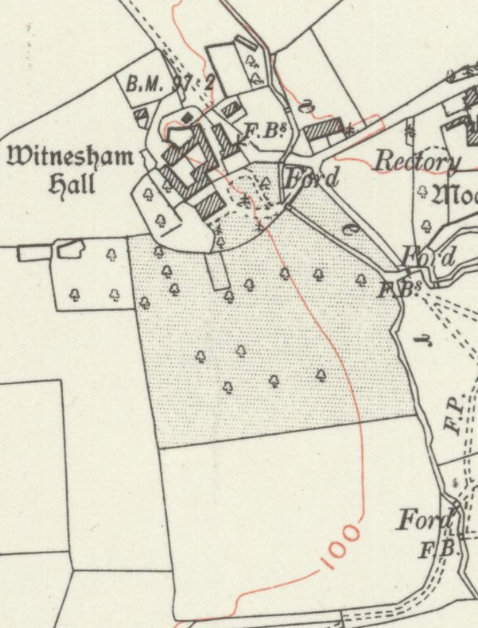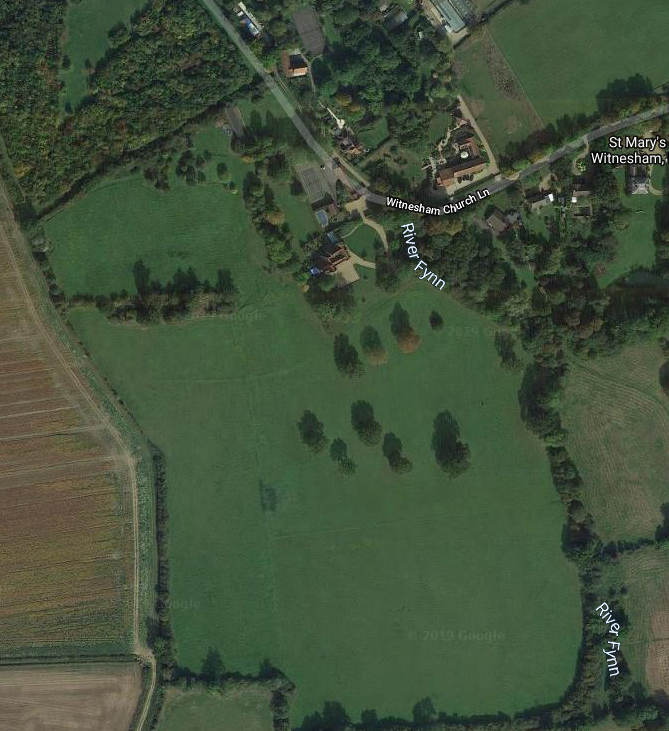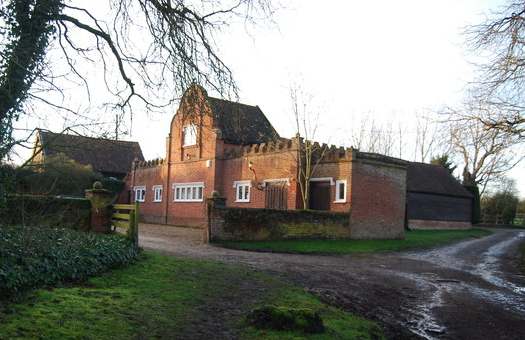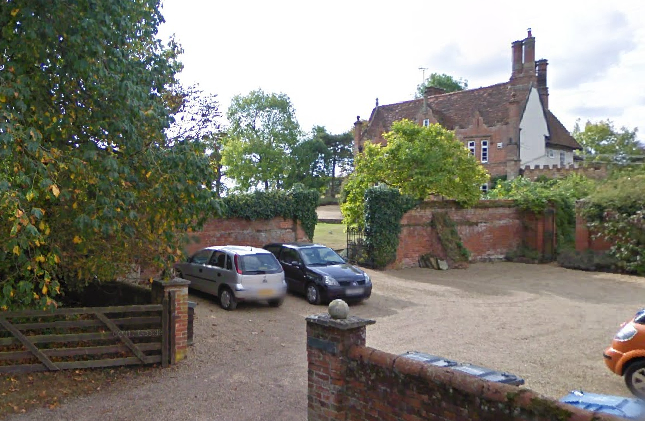Parish: WITNESHAM
District Council: EAST SUFFOLK (previously Suffolk Coastal)
TM 177 508
Not open to the public

The ancient manorial site of Witnesham Hall is close to the Church of St Mary (Grade I) c. 5.6km (3.5mls) north-east of Ipswich. Near its headwaters, the River Fynn flows through the grounds as a brook, making its way to join the River Deben through Martlesham Creek to the south-east. To the west is Witnesham Thicks, the remains of ancient woodland that was once far more extensive and part of the manorial holding but now in Henley parish.
Witnesham was the seat of the Meadows (Meadowe/Medows) family from the fourteenth century until 1858. The former manor house of Witnesham Hall (Grade II*) was built in the mid-sixteenth century with alterations c. 1614, probably for William Meadowe. It is believed to have been the birthplace of the Revd William Kirby (1759–1850), the well-known entomologist and botanist who developed his interest in natural history from his mother Lucy Meadowe (d. 1776) who was married to William Kirby. The Revd William became rector of Barham and died at his home of Barham Rectory.
The house was extensively remodelled c. 1841 for Daniel Charles Meadows, heir to the Revd Philip Meadows (1777–1837) of Witnesham and rector of Great Bealings. Philip lived at Bealings Place, later known as The Lodge, in the Great Bealings parish. This remodelling of Witnesham Hall saw much of the house encased in red brick, although a three-storey Flemish gable brick entrance porch of c. 1614 survives on the south-facing elevation from where there are views over parkland and the river valley. To the rear of the house there was a yard and barn complex. This included a surviving listed coach house (Grade II), plus screening wall, gate piers, and linking arm of the wall to the north corner of the house (Grade II). All are eighteenth century, but were remodelled at the same time as the house.
Although documentary evidence is not known to exist, the style and use of round-arched gable ends on the house is suggestive of the work of Perry Nursey (1771–1840), who lived at The Grove in Little Bealings. He was an amateur artist and proponent of the picturesque style and advertised his credentials as an architect and landscaper. Perry was in the same social circle as Daniel Meadows and his son Poussin was married to Daniel’s sister Catherine, so it would be surprising if he did not have some influence on the design of the house. A lithograph of c. 1852 by Augustus Butler shows the south and east elevations of the house after the remodelling. A fence separates a small area of garden from the parkland, described on the 1843 tithe apportionment as ‘meadow’, with grazing sheep and people taking the air. Bringing the natural pastoral scene so close to the house is reminiscent of Nursey’s views on picturesque landscape beauty, suggesting he may also have advised on the pleasure gardens and parkland setting. The River Fynn was bridged to give access to the house from the east. The tithe map shows an orchard to the west of the house.


Soon after the remodelling of the house, Witnesham Hall was recorded on the 1851 census as being a farmhouse occupied by the Gooding family who remained there into the early part of the twentieth century. Previously sold by the Meadows family, in 1929 the whole Witnesham Hall Estate of c. 109ha (269a), including the Hall and outbuildings plus the Manor Farm, numerous cottages and the post office were offered for sale by the trustees of the will of the late Mr. J. G. Clarke.
Today the Hall is a private house and the coach house has been converted to office space. Most of the surrounding landscape remains much as it was in the nineteenth century, with the River Fynn bridged and flowing through part of the parkland, although it has been extended by taking in arable fields to the south and west. Some barns have been demolished to make way for pleasure gardens to the rear of the house. The gardens and park amounted to c. 12ha (30a) when it was for sale in 1986 and again in 2020.


SOURCES:
Bettany, George, Thomas, Dictionary of National Biography, 1885–1900, Vol. 31.
Burke, Bernard, A Visitation of Seats and Arms of the Noblemen and Gentlemen of Great Britain, Vol. 2, 1855.
Copinger, W. A., The Manors of Suffolk, Vol. 3, 1909.
Foster, Joseph, The Peerage Baronetage and Knightage of the British Empire, 1880.
History of the Commoners of Great Britain and Ireland, 1835.
Sandon, Eric, Suffolk Houses, A Study of Domestic Architecture, 1977.
The Pole for the Knights of the Shire for the County of Suffolk, taken at Ipswich, 1710.
White, C. H. Evelyn, Ed., The East Anglian; or Notes and Queries, Suffolk, Cambridge, Essex & Norfolk, Vol. 5, 1893–94.
Quote from Nursey in an advertisement for the sale of The Grove in The Times on 28 May 1821, information courtesy of Anthony Adolf, https://anthonyadolph.co.uk.
East Anglian Daily Times. ‘Yours for £2.5m – historic 8-bedroomed manor house with pool and cinema room’ (https://www.eadt.co.uk/lifestyle/21404390.2-5m—historic-8-bedroom-manor-house-pool-cinema-room/, 15 March 2020.)
Census: 1851, 1861, 1871, 1881, 1891, 1901, 1911.
1843 (surveyed 1840) tithe map and apportionment.
1884 (revised 1881 to 1883) Ordnance Survey map.
1905 (revised 1902) OS map.
1928 (revised 1925) OS map.
2021 Google aerial map (Imagery © Bluesky, CNES / Airbus, Getmapping plc, Infoterra Lts & Bluesky, Maxar Technologies, Map data © 2021).
Heritage Assets:
Suffolk Historic Environment Record (SHER): WTN Misc, HEN 005.
Witnesham Hall, Church Lane (Grade II*), Historic England No: 1030518,
Stabling and Coach Houses 40 metres north of Witnesham Hall (Grade II), Historic England No: 1030519
Walling, Gate Piers and Gates attached to north corner of Witnesham Hall (Grade II), Historic England No: 1284174.
Church of St Mary, Historic England (Grade I), Historic England No: 1183185.
Suffolk Record Office (now Suffolk Archives):
Suffolk Record Office (The Hold, Ipswich) HE 402/2/1929/8. Witnesham Hall Estate, Witnesham and Henley Sales Particulars, 25 June 1929.
SRO (Ipswich) HD 2833/1/SC475/12. Witnesham Hall Sales Particulars, 1986.
Site ownership: Private
Study written: February 2023
Type of Study: Desktop/external visits 2019 to 2023
Written by: Tina Ranft
Amended:
